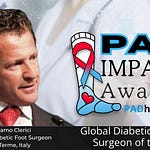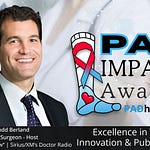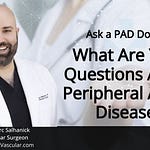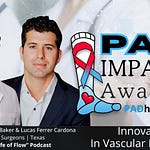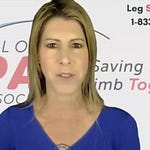For many patients with Peripheral Artery Disease (PAD), restoring blood flow through revascularization procedures is just the beginning of their journey toward relief. Even after successful intervention, persistent pain—often from nerve damage—can significantly impact quality of life. In a recent conversation with Dr. Elsie Koh, Chief Medical Officer of American Endovascular, and Allie, a representative from Nevro, we explored an advanced option that's helping PAD patients find relief when traditional methods fall short: spinal cord stimulation.
When Blood Flow Returns But Pain Persists
PAD, particularly in its advanced stage known as Critical Limb Ischemia (CLI), often leads to nerve damage that doesn't automatically heal when circulation improves. As Dr. Koh explains, "Maybe their wound heals, but they can't feel their feet." For these patients, the burning, tingling, and sometimes debilitating pain continues despite successful intervention to open blocked arteries.
What happens in these cases? The nerves, damaged by prolonged oxygen deprivation, send pain signals that no longer serve a useful purpose. They're essentially "false alarms" that the brain continues to process as pain.
Understanding Neurostimulators: A New Horizon for Relief
Neurostimulators, specifically high-frequency spinal cord stimulators, work by interrupting these pain signals before they reach the brain. Unlike the older TENS units that many patients have tried, these implantable devices provide targeted, consistent relief.
"We're basically stimulating the specific area in your spine to block that pain from going to your brain," Dr. Koh explains. "That pain message from these mangled nerves that are no longer functioning and serving you well and creating significant pain...we're just blocking that signal so it's not translated and you don't feel it."
Nevro's high-frequency spinal cord stimulation technology has been FDA-approved since 2015, helping over 100,000 patients with chronic pain. While initially used for back and leg pain, the indication for diabetic neuropathy was approved in 2022—a significant advancement for PAD patients, many of whom also have diabetes.
The Two-Step Process: Try Before You Commit
What makes neurostimulators particularly appealing is the trial period that precedes permanent implantation, allowing patients to experience the benefits before making a long-term commitment.
The Trial Period
The trial procedure is minimally invasive and performed under twilight sedation (fentanyl and Versed) with local anesthesia. Dr. Koh describes the leads as "tiny little fishing wires for tiny fish" that are placed in the epidural space—the same area where epidural injections for pain are administered.
During this week-long trial, patients wear an external battery pack taped to their back. This allows them to test the device and determine if it provides adequate relief.
"If your results are greater than 50%, you now can go to the next level, which is the permanent one," Dr. Koh notes. In fact, she shares that her most recent patient reported "100% improvement in my left leg, 50% improvement in my right leg, and 50% improvement in my low back."
Permanent Implantation
If the trial proves successful, the permanent device is implanted in a second procedure. This involves placing the same type of leads but connecting them to a small, rechargeable battery that's embedded under the skin on the back or flank.
"It's like putting a pacemaker," Dr. Koh explains. "Some patients have seen a pacemaker up here [points to chest] and you can see a tiny battery pack there. The same thing will be for these patients."
The battery lasts 10-15 years and can be recharged externally through Bluetooth technology—no need for replacement surgery until the battery life ultimately expires.
Who Is a Candidate for Neurostimulation?
Not everyone with PAD-related pain is immediately eligible for a neurostimulator. Dr. Koh outlines the typical patient journey:
1. First, patients should undergo treatment for their peripheral arterial disease.
2. They should try conservative therapies like medications (gabapentin is commonly prescribed for neuropathy).
3. They should have a formal diagnosis of neuropathy with symptoms like numbness, tingling, burning sensation, or what some describe as "feet on fire."
4. Physical therapy should be attempted.
5. If diabetes is present, it should be reasonably controlled with an A1C under 10.
"After we've tried that," Dr. Koh explains, "we will submit it and have you go for a trial. Most insurances will pay for this procedure."
Living with a Neurostimulator: Recovery and Lifestyle
The recovery process involves some initial limitations but leads to expanded capabilities for many patients. After implantation, patients can expect:
- Soreness at the incision sites for the first week
- Limited twisting, bending, and lifting initially
- Sponge baths only until the wounds are confirmed healed (typically one week)
- Gradual increase in stimulation levels over time
Remarkably, once fully healed (typically 6-8 weeks for scar tissue to build around the leads), there are few restrictions on activities. Allie notes that they've had patients who have successfully run marathons and completed triathlons with these devices.
Dr. Koh emphasizes the importance of giving the body time to heal: "You need to allow some time for that scar tissue to build up to maintain those leads in place." While immediate post-procedure restrictions are necessary, the long-term goal is to help patients return to normal activities.
The Personal Impact: Beyond Pain Relief
The benefits extend beyond just pain reduction. Dr. Koh shares that some patients report being able to "finally sleep through the night" and consequently feel more energized and active. Others can finally walk to their local store—a simple activity for many, but life-changing for those who've been limited by pain.
Allie explains how the device evolves with the patient's needs: "If you decide to move forward to the permanent device, what we do is we download an app on the phone and you answer four questions daily." These questions track pain relief percentage, pain scale, activity changes, and medication changes. Based on these responses, the device adjusts to the optimal program for each individual.
Additionally, every patient is assigned a coach they can call with questions, and representatives like Allie are available during business hours to help reprogram the device, either over the phone or in person.
Addressing Common Concerns and Questions
Will It Interfere with Other Medical Devices?
For patients with stents, pacemakers, or defibrillators, the good news is that interference is rare. Neurostimulators can safely coexist with stents in the legs, and while pacemaker representatives sometimes monitor their device during neurostimulator implantation, issues are uncommon.
What About Airport Security?
Patients receive a card identifying their implantable device. TSA is familiar with these devices and will typically direct patients through a standard metal detector rather than the body scanner. Allie notes that spinal cord stimulators are now included on TSA posters, making the process smoother.
How Are Adjustments Made Over Time?
The device's settings are personalized to each patient through an algorithm that learns from daily feedback. However, human support is always available—patients can call their assigned coach or representative for adjustments or questions.
What Happens When the Battery Eventually Needs Replacement?
After 10-15 years, the battery may need replacement. This is a simple 10-15 minute procedure that involves making a small incision to remove the old battery pack and insert a new one, while the leads remain in place.
Potential Complications and Considerations
As with any procedure, there are potential complications, though Dr. Koh notes they're relatively rare:
- Infection: Preventive measures include IV antibiotics before the procedure and a five-day course of oral antibiotics afterward.
- Bleeding: Patients must stop blood thinners, aspirin, and NSAIDs at least one week before the procedure.
- Lead migration: The wires can potentially move, especially if proper healing time isn't allowed or with extreme physical activities.
- Weight and breathing considerations: Very heavy patients or those with breathing problems like COPD may not be candidates due to the requirement to lie face-down during the procedure.
An Unexpected Benefit: Improved Circulation?
While not yet approved in the U.S. for this purpose, Dr. Koh shares an intriguing development: "In Europe, they use neurostimulators to help improve the blood flow to the foot...it causes vasodilation of some of the blood vessels."
This suggests that beyond pain relief, these devices might help stimulate collateral blood vessels—particularly beneficial for patients with limited vessel options for revascularization. While more research is needed, this possibility offers hope for patients with the most challenging circulation problems.
Taking the Next Step: Questions to Ask Your Doctor
If you're considering a neurostimulator for PAD-related pain, Dr. Koh recommends being prepared with your medical history, including:
- What medications you've tried for neuropathy
- What blood thinners you're taking
- How long you've had diabetes (if applicable)
- Whether you've seen a neurologist
- Details about your symptoms
- Previous back surgeries (crucial information that can affect lead placement)
Being organized about your health history helps your doctor determine if you're a good candidate and how to best approach your treatment.
The Bottom Line
For PAD patients who continue to suffer despite revascularization, neurostimulators represent a promising option. The technology offers not just pain relief but potentially improved quality of life, increased activity levels, and better sleep.
If you're interested in learning more about neurostimulators, visit Nevro’s Website or contact American Endovascular if you're in the New York/New Jersey area.
Remember that the path to relief often requires persistence and self-advocacy. As Dr. Koh emphasizes, "Don't just take it...if your symptoms are not matching that image...get a second and third opinion."
If you have questions about Peripheral Artery Disease (PAD) and available treatment options, call the Global PAD Association’s Leg Saver Hotline at 1-833-PAD-LEGS or go to PADhelp.org.
---
Disclaimer: This information is for educational purposes only. Always consult with your healthcare provider before making decisions about your treatment. The Global PAD Association does not endorse products, treatments, or physicians. So, make sure to talk to your healthcare team about the right care for your presentation of disease.
Have you or someone you know tried neurostimulation for PAD-related pain? Share your experience in the comments below.




